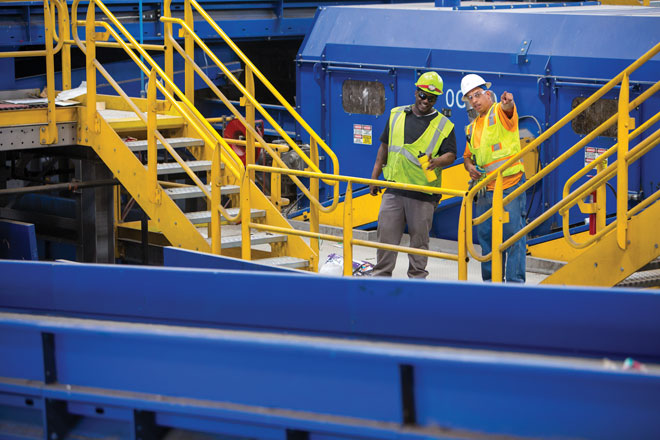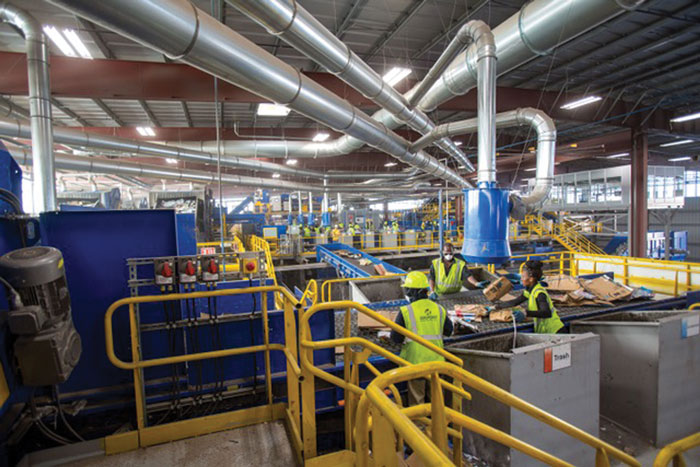MRFs need to have a plan to, first and foremost, keep people safe, and also to reduce claims costs. It is something that needs to be addressed every day, hour by hour.
By Brian Haney
Every MRF shares a common safety concern: the work environment presents an inherent risk for slips, trips and falls. All plants have multiple levels and configurations of platforms, stairs and steps. Loose material is often present. Transitional stairways create added danger from workers carrying buckets, garbage cans and other items that can impair vision, balance and access. And about those workers: they are human like the rest of us. They can get distracted. They get in a hurry to get to their breaks or to leave at the end of their shift.
An MRF’s OSHA log likely tells the story of injuries from slips, trips and falls. These injuries tend to be severe, including torn ligaments, damaged shoulders, back issues and knee trauma. Additionally, they tend to have higher workers’ compensation claims costs associated with them. The risk of serious injury from careless footwork is a constant, ongoing issue that requires persistent management. MRFs need to have a plan to, first and foremost, keep people safe, and also to reduce claims costs. It is something that needs to be addressed every day, hour by hour. Injuries from slips, trips and falls are created by unsafe conditions and unsafe actions. We all have an OSHA-mandated duty to provide a workplace free from recognized hazards.

Photos courtesy of Leadpoint.
Unsafe Physical Conditions
There are two categories of physical conditions that create slip, trip and fall hazards in an MRF: maintenance and design. Stairways should be inspected on a daily basis to look for steps, handrails or guardrails that are bent or damaged.
Housekeeping also needs to be closely managed. Any time you have two pieces of paper together, you create a slip hazard. Material left on the floor or on stairs is an issue. The baling area can be especially dangerous because of how wet and slippery the floor can become.
OSHA design standards for the angle and run-over-rise of any stairway are meant to reduce the likelihood of injury while ensuring an efficient operation. When building or renovating a MRF, these standards must be consulted and followed to create a safe workplace.

Unsafe Actions and Behaviors
Simply put, MRFs are dangerous places to work. I’m reminded of an employee who said, “I never realized this job could kill me” after he completed our safety training. We remind our people every day that they cannot sleepwalk through the site. We tell them, “Your brain has to be turned on from the second you arrive until the moment you leave the plant at the end of your shift.”
Common examples of distraction and inattentiveness are looking at your phone while walking or working, not using three points of contact, and rushing to get to or from a break on time. It is just too easy for MRF employees to lose focus during any of these transitions.
Five Prevention Recommendations
MRF operators and managers can get in front of the physical and behavioral challenges that can lead to slips, trips and falls by following these five recommendations.
- Daily walk through. At the start of each shift, look for physical hazards that might be present. Things change in the MRF on a daily basis. Do not assume that what was safe yesterday is still safe today. Anything you identify must become a repair priority for the day.
- Housekeeping. Have a housekeeping plan that is executed throughout the day. Assign people to specific tasks and areas of the MRF. Make sure someone is assessing the condition of the stairs, landing areas, tops and bottoms. Empower the team to address any hazards immediately.
- Transition times. It cannot be overstated: slips, trips and falls are most likely to happen at breaks, lunch time and end of shift. Pay special attention to behavior and enforce safe practices during these transition times. Line leads and shift managers need to be observant. If they see people rushing or walking while using the phone, they must step in and say something. If they do not, they condone that unsafe behavior.
- Signage. Line leads and managers cannot be everywhere all the time. Visual reminders about things like using three points of contact make a difference in promoting safe behavior. Signage is an indicator that a hazard is present. In addition to posted reminders, paint transition areas yellow to indicate a step or change in elevation. Then, keep the paint bright and fresh.
- Culture. Preventing slips, trips and falls has to be a point of emphasis and reinforced as part of the culture for leaders and employees. Set the stage from the beginning as new employees are hired, oriented and trained. Reinforce hazard identification and safe behavior in daily toolbox talks. If the culture starts to shift and incident rates rise, bring people in and reemphasize the importance of working safe and preventing slip, trip and fall injuries.
Be a Safety Leader
As MRF managers, we are also safety leaders. Preventing slips, trips and falls has to be top-of-mind for everyone, every day. It has got to be a consistent point of emphasis. Do not become complacent. If you do, it will bite you. More importantly, it will bite your employees. Hazards are inherent in our industry. They will not go away and cannot be ignored. | WA
Brian Haney is Vice President of Safety and Compliance for Leadpoint Business Services (Pheonix, AZ). Leadpoint provides high performance work teams in high production environments and specializes in recycling facility operations across the U.S. They have the experience and technical expertise to help you reduce the risk of slips, trips and falls, mitigate workers’ compensation claims, and create a safer environment at your MRF. Brian has more than 25 years of environmental, health and safety practice across multiple geographic regions and industries. Prior to working for Leadpoint, Brian was corporate EHS manager for oil and antifreeze recycler West Group Safety and compliance manager for a Fortune 500 waste and recycling organization. He also worked as a senior EHS consultant for a national consulting firm. Brian is a member of the Solid Waste Association of North America (SWANA) and the National Waste and Recycling Association (NWRA) Safety Committee. He currently serves on the ANSI Z245 committee responsible for standards related to the solid waste and recycling industry. Brian can be reached at [email protected].
References
www.osha.gov/laws-regs/oshact/section5-duties
www.osha.gov/laws-regs/regulations/standardnumber/1910/1910.25
